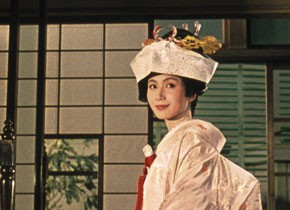Ozu Yasujirō
The Complete Works
January 7 to February 7, 2011
A complete Ozu retrospective is a rare event in itself. The costs and logistics of such an endeavor are usually prohibitive, which means that, contrary to the reputation enjoyed by the director’s oeuvre, it is hardly ever presented in its totality. The Austrian Film Museum is grateful to its partners, the Japan Foundation, Shochiku, and the Japanese embassy in Vienna, for the opportunity to stage this special project at the beginning of 2011.
At first glance, Ozu’s distinctive style and thematic focus suggest a kind of mastery that can be easily summed up. His films are gendai-geki (set in the present) and, with few exceptions, revolve around a single subject: the Japanese family. Their formal design supplies other “trademark” characteristics: a static camera, placed at a low height, often gazing directly at the characters; a rejection of classical editing patterns (such as the ‘180 degree rule’ or the eyeline match); “pillow shots” which create a unique kind of breathing space between scenes. Ozu’s films are also regarded as contemplative, as extreme cases of the purity associated with “Zen”, a culture of nothingness. In the West, this “most Japanese of all directors” was discovered later than other masters among his compatriots; while highly successful at home, his films were long thought of as unsuitable for foreign markets.
Ozu’s late work (the thirteen films made between 1949 and 1962) is usually seen as the defining core of his aesthetic – from Banshun (Late Spring) to Tōkyō monogatari (Tokyo Story) to Akibiyori (Late Autumn) and Samma no aji (Autumn Afternoon). The distinctions between individual films seem to recede behind the view of the world that they represent as a cycle – a movement of recurring narratives (such as the story of a father who wants to marry off his daughter), employing a fixed arsenal of highly restrained visual means. Ozu has compared his work to the sea: Like waves quietly spreading out to the horizon, the films may appear identical to each other, yet each one is different – a metaphor that seems even more apt when considering the unfathomable depths which lie beneath the ocean’s surface. The same could be said about Ozu’s interiors: seemingly alike at first glance, the carefully arranged props shift nearly imperceptibly from one shot to the next – just as each of the films reveals an infinite variety of nuance and mood with each new viewing.
Any attempt at describing the richness of Ozu’s art must also take into account the less canonical ‘waves’ in his career. It is in these earlier (and larger) parts of his filmography, from 1929 to 1948, that he seems to come alive as a real person again – far from the isolated, almost godlike creature that Western film critics have constructed in their reading of his later works. Ozu developed his filmmaking language and many of his characteristic themes not as a loner, but as part of a group of other exceptional talents at Shochiku (including Naruse, Shimizu, Gosho and Uchida), who ushered in an era of stunningly modern cinema around 1930. His great works of this period also reveal a highly versatile and inventive director of genre films who could easily alternate between slapstick comedies, social dramas and gangster movies.
American films exerted a strong influence on Japanese cinema at the time. Even more than his colleagues, Ozu was an obsessive cinephile who loved American movies from childhood on. His own films are full of appropriate references, including innumerable posters that appear in his interior and exterior scenes. In some cases, this extends to the subject matter: Ozu’s early masterpiece Dekigoro (1933) was obviously inspired by King Vidor’s The Champ; two decades later, Leo McCarey’s Make Way for Tomorrow finds a close relative in Tokyo Story. Thus, the “most Japanese of directors” can also be viewed as the most American of Japanese directors, a notion that accords with Ozu’s own image of himself. Like the greatest of his American colleagues he developed his personal style and unique view of humanity within a commercial system and with a “family” of proven collaborators who stayed with him for several decades. In the process, he rejected every artistic affectation; he preferred to compare his craft with that of a tofu manufacturer.
Against this background, Ozu might be best understood as a popular artist. Considering his refined and subtly radical aesthetic, it is certainly legitimate to see him as an avant-garde figure, or, given the spiritual profundity of his work, as a transcendentalist. In truth, however, the perception of Ozu’s greatness does not depend on any intellectual superstructure; it is grasped intuitively. What he discovered was the art of absolute harmony: the details of his scenes reflect the greater form of the individual film and in some ways Ozu’s entire career (or the essence of cinema itself). Within the image of peeling a Japanese pear: an entire life with all its tragedy and beauty (or the essence of existence and death). After suffering from cancer, Ozu died on December 12, 1963, his 60th birthday. His death came shockingly early – but he left us an infinity.
Related materials
